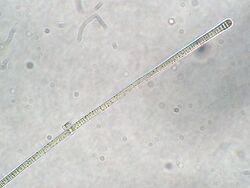Biology:Oscillatoria brevis
| Oscillatoria brevis | |
|---|---|

| |
| Oscillatoria brevis | |
| Scientific classification | |
| Domain: | Bacteria |
| Phylum: | Cyanobacteria |
| Class: | Cyanophyceae |
| Order: | Oscillatoriales |
| Family: | Oscillatoriaceae |
| Genus: | Oscillatoria |
| Species: | O. brevis
|
| Binomial name | |
| Oscillatoria brevis Kützing ex Gomont 1892[1]
| |
Oscillatoria brevis is a species of the genus Oscillatoria first identified in 1892.[2] It is a blue-green filamentous cyanobacterium, which can be found in brackish and fresh waterways.[3][4] O. brevis can also be isolated from soil.[5]
Oscillatoria brevis is a mesophile but can bear a temperature of -16°C,[6] and can perform photosynthesis at a temperature of 70°C.[7] It is a photoautotroph, containing Chlorophyll a and c-phycocyanin, but can perform anoxygenic photosynthesis by reducing sulfur.[8] It is able to fix nitrogen, and can be cultured from soils. It, along with other nitrogen fixing cyanobacteria found in the soil, has been found to positively correlate with soil richness and the microbe density.[5] O. brevis has also been shown to be tolerant of some heavy metal ions, namely copper, silver, zinc, and cadmium.[9]Oscillatoria is able to glide via microfibrils. The genus name Oscillatoria is in reference to the look of oscillation when gliding.[10] The species name, brevis, is Latin for short or small, yet the microbe is 10 μm wide and length varies in the genus from 5–70 μm.[4]
Metabolites
Oscillatoria brevis is identified as an cyanobacteria that produces Geosmin, a compound with a heavy earthy smell, which correlates with chlorophyll production.[11] Like many cyanobacteria, O. brevis have lipopolysaccharides which can cause illness in humans and animals through ingestion or through an open wound.[12] Other species in the Oscillatoria genus have been identified to have genes for producing cytotoxin, cylindrospermopsin, along with two neurotoxins, anatoxin-a and homoanatoxin-a.[13]
References
- ↑ ":: Algaebase". AlgaeBase. http://www.algaebase.org/search/species/detail/?species_id=66293.
- ↑ "Oscillatoria brevis Kützing ex Gomont 1892 :: Algaebase". https://www.algaebase.org/search/species/detail/?species_id=66293.
- ↑ Brown, Igor I.; Fadeyev, Sergey I.; Gerasimenko, Lyudmila M.; Kirik, Irina I.; Pushenko, Marina Ya.; Severina, Inna I. (1990-03-01). "Sodium ions are necessary for growth and energy transduction in the marine cyanobacterium Oscillatoria brevis" (in en). Archives of Microbiology 153 (4): 409–411. doi:10.1007/BF00249014. ISSN 1432-072X. https://doi.org/10.1007/BF00249014.
- ↑ 4.0 4.1 Muhlsteinova, Radka; Hauer, Tomáš; Ley, Paul; Pietrasiak, Nicole (2018-05-01). "Seeking the true Oscillatoria: A quest for a reliable phylogenetic and taxonomic reference point". Preslia 90. doi:10.23855/preslia.2018.151. https://www.researchgate.net/publication/324890824.
- ↑ 5.0 5.1 Afify, Aida; Hauka, Fathy; Gaballah, Mahmoud; Abou Elatta, Ahmed (2018-06-01). "Isolation and Identification of Dominant N2 Fixing Cyanobacterial Strains from Different Locations". Journal of Agricultural Chemistry and Biotechnology 9 (6): 141–146. doi:10.21608/jacb.2018.35217. ISSN 2090-3626. https://jacb.journals.ekb.eg/article_35217.html.
- ↑ "Cyanophyta: Micro-cystic and Oscillatoria (With Diagrams)" (in en-US). 2016-02-04. https://www.biologydiscussion.com/algae/life-cycle-algae/cyanophyta-micro-cystic-and-oscillatoria-with-diagrams/21005.
- ↑ Darpan, Pratiyogita (August 2001) (in en). Competition Science Vision. Pratiyogita Darpan. https://books.google.com/books?id=TegDAAAAMBAJ&q=oscillatoria+brevis+photosynthesis+70&pg=PT12.
- ↑ Millie, David F.; Ingram, Daphne A.; Dionigi, Christopher P. (December 1990). "Pigment and Photosynthetic Responses of Oscillatoria Agardhii (Cyanophyta) to Photon Flux Density and Spectral Quality1" (in en). Journal of Phycology 26 (4): 660–666. doi:10.1111/j.0022-3646.1990.00660.x. ISSN 0022-3646. https://onlinelibrary.wiley.com/doi/10.1111/j.0022-3646.1990.00660.x.
- ↑ Tong, Liu; Nakashima, Susumu; Shibasaka, Mineo; Katsuhara, Maki; Kasamo, Kunihiro (2002-09-15). "A Novel Histidine-Rich CPx-ATPase from the Filamentous Cyanobacterium Oscillatoria brevis Related to Multiple-Heavy-Metal Cotolerance". Journal of Bacteriology 184 (18): 5027–5035. doi:10.1128/JB.184.18.5027-5035.2002. PMID 12193618.
- ↑ "Oscillatoria". http://oceandatacenter.ucsc.edu/PhytoGallery/Freshwater/Oscillatoria.html.
- ↑ Naes, H.; Aarnes, H.; Utkilen, H. C.; Nilsen, S.; Skulberg, O. M. (June 1985). "Effect of Photon Fluence Rate and Specific Growth Rate on Geosmin Production of the Cyanobacterium Oscillatoria brevis (Kütz.) Gom". Applied and Environmental Microbiology 49 (6): 1538–1540. doi:10.1128/aem.49.6.1538-1540.1985. ISSN 0099-2240. PMID 16346822. Bibcode: 1985ApEnM..49.1538N.
- ↑ Stewart, Ian; Schluter, Philip J.; Shaw, Glen R. (2006-03-24). "Cyanobacterial lipopolysaccharides and human health – a review". Environmental Health 5 (1): 7. doi:10.1186/1476-069X-5-7. ISSN 1476-069X. PMID 16563160.
- ↑ Méjean, Annick; Mazmouz, Rabia; Mann, Stéphane; Calteau, Alexandra; Médigue, Claudine; Ploux, Olivier (October 2010). "The genome sequence of the cyanobacterium Oscillatoria sp. PCC 6506 reveals several gene clusters responsible for the biosynthesis of toxins and secondary metabolites". Journal of Bacteriology 192 (19): 5264–5265. doi:10.1128/JB.00704-10. ISSN 1098-5530. PMID 20675499.
Wikidata ☰ Q39087436 entry
 |

